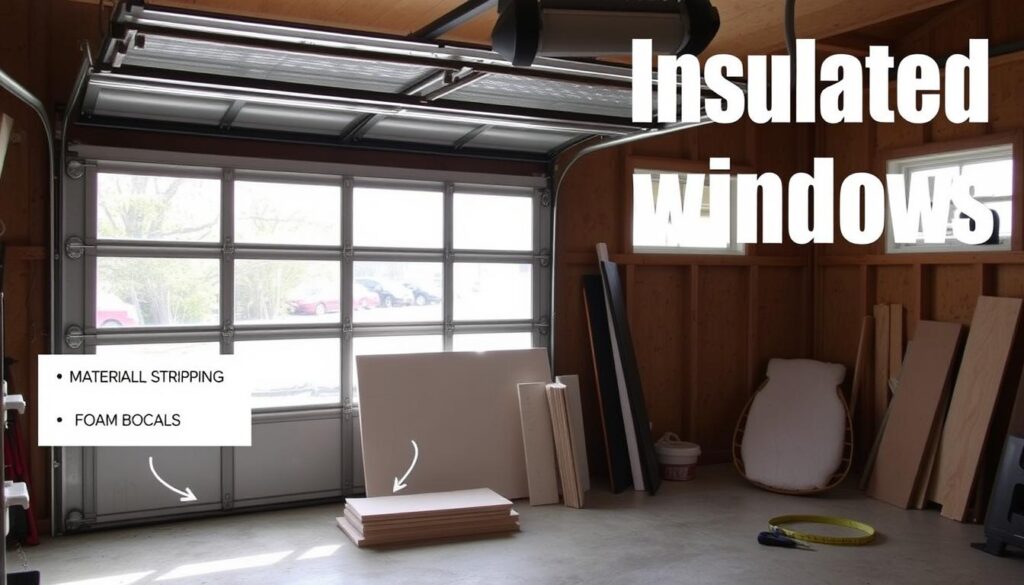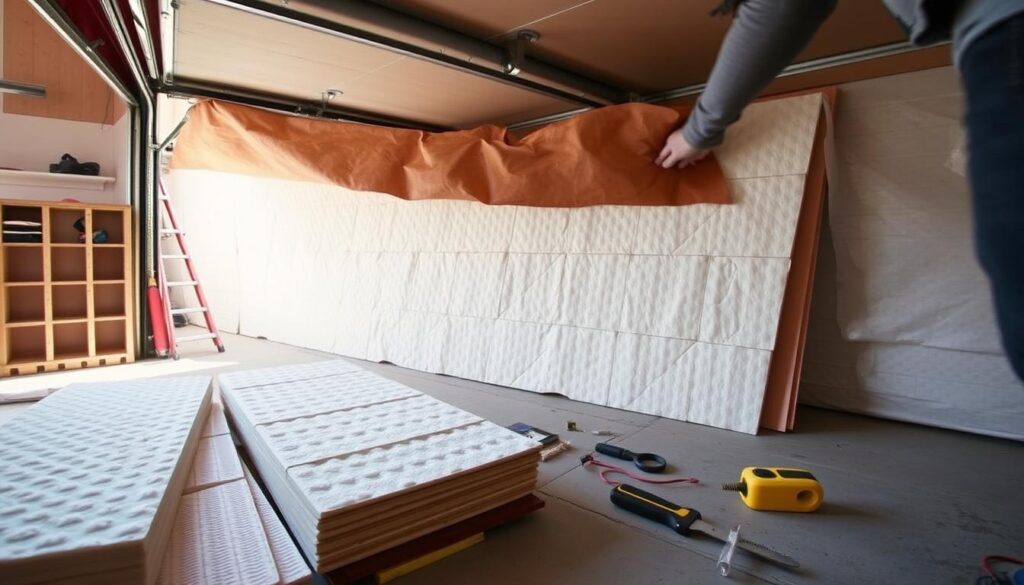Want to make your home more energy-efficient and cozy? Insulating your garage door is a smart move. This guide will show you how to do it yourself and make your garage warm and energy-saving.
Key Takeaways
- Insulating your garage door can make your home more energy-efficient and comfortable.
- DIY garage door insulation is a budget-friendly option that’s easy to do with the right tools and materials.
- By insulating your garage door, you can save a lot on energy and help the environment.
- Don’t forget to insulate your garage door windows for the best results.
- It’s important to keep your insulated garage door in good shape to ensure it works well for a long time.
Why Insulate Your Garage Door?
Getting an insulated garage door can really help your home. It stops heat from moving in or out, making your home more energy-efficient. This means lower bills and a cozier living space.
It also makes your garage more comfortable. This makes it a nicer place to be all year round.
Improved Energy Efficiency
An insulated garage door keeps your home warm in winter and cool in summer. This means your heating and cooling systems work less hard. This can save you a lot of money on your bills.
The right insulation can make your whole home more energy-efficient. This can save you hundreds of dollars a year.
Enhanced Comfort
Insulating your garage makes it a better place to be. Whether you use it for storage, a workshop, or as extra living space, it’s more comfortable. The insulation keeps the temperature steady and blocks drafts.
This makes your garage a cozy spot. It’s more functional and fun to use.
In short, are insulated garage doors worth it? Absolutely. They save you money and make your home more comfortable. Getting the best insulation for garage doors is a smart choice for your home.
Preparing for the Insulation Project
Before starting your DIY garage door insulation project, make sure you’re ready. This prep work will help you install insulation smoothly and efficiently. It will make your garage more energy-efficient and cozy.
First, check your garage door’s condition. Look for any damage, cracks, or weak spots. Fixing these issues first is key to a successful insulation job.
Then, measure your garage door accurately. Knowing its exact size helps you pick the right insulation materials. Make sure to measure length, width, and thickness for a perfect fit.
- Inspect the garage door for any existing damages or areas that need attention.
- Measure the length, width, and thickness of the door to determine the required insulation materials.
- Gather the necessary tools and accessories, such as a utility knife, measuring tape, and safety equipment.
- Ensure you have a clean and well-lit work area to facilitate the installation process.
Finally, collect all the tools and safety gear you’ll need. This includes a utility knife, measuring tape, and safety items like gloves and eye protection. Having everything ready will make the installation go smoothly.
By preparing well for your can you insulate garage door project, you’ll ensure success. This prep work is essential for turning your garage into a cozy and energy-saving space.
Materials Needed for DIY Garage Door Insulation
To insulate your garage door and save energy, you’ll need the right stuff. Choosing the best insulation can really help your home stay cozy and cut down on bills.
Insulation Materials
There are many ways to insulate your garage door. Here are some top picks:
- Foam boards: These panels are easy to cut and install. They keep your garage warm and quiet.
- Reflective insulation: It uses a shiny surface to block heat. It’s perfect for garage doors.
- Insulation kits: These kits are made for garage doors. They make installation easy and ensure a good fit.
Tools and Accessories
You’ll also need some tools and accessories for your project. Here’s what you’ll need:
- Tape measure: Use it to measure your garage door. This ensures the insulation fits right.
- Utility knife or scissors: Cut the insulation panels to the right size with these.
- Glue or sealant: You’ll need this to stick the insulation to your garage door.
- Protective gear: Wear gloves, safety glasses, and a dust mask. It keeps you safe while working with insulation.
With the right materials and tools, you’re ready to insulate your garage door. You’ll enjoy a more energy-efficient garage.
“Properly insulating your garage door can significantly improve your home’s energy efficiency and comfort.”
Step-by-Step Guide to Insulating Your Garage Door
Insulating your garage door is a simple DIY project. It can make your home more energy efficient. Follow these steps to insulate your diy insulate garage door and enjoy the benefits.
Cleaning and Preparing the Door
Begin by cleaning your garage door thoroughly. Use a mild detergent and a clean cloth to remove dirt, debris, or old sealants. This makes the surface ready for insulation.
Measuring and Cutting the Insulation
Measure your garage door panels to figure out the insulation size you need. Remember to include any windows or obstructions. Then, cut the insulation to fit each panel with a utility knife or scissors.
Installing the Insulation Panels
Apply a lot of adhesive to the insulation panels’ back. Place them on the garage door panels and press hard for a strong bond. If needed, use screws or fasteners to secure the insulation. Take your time for a tight, seamless fit to get the best how to insulate garage door panels results.
By following these easy steps, you can insulate your garage door. You’ll see better energy efficiency and comfort.
diy insulate garage door
Insulating your garage door yourself can save you money and be very rewarding. By preparing well, getting the right materials, and following a step-by-step guide, you can make your garage door more energy-efficient and cozy.
The advantages of diy insulate garage door are many. It can make your home more energy-efficient and your garage more comfortable. This makes your garage a nicer place to be all year round.
To start, make sure you have the right tools and materials. You’ll need insulation panels, adhesive, and tools for cutting and installing. With some preparation and hard work, you can confidently complete this project.
- Measure your garage door precisely to determine the correct size of insulation panels needed.
- Thoroughly clean the door surface to ensure a secure bond for the insulation.
- Carefully cut the insulation panels to fit the dimensions of your garage door.
- Apply the adhesive and firmly press the insulation panels into place.
- Enjoy the improved energy efficiency and comfort of your newly insulated garage door.
Choosing to diy insulate garage door can save you money and give you a sense of accomplishment. With patience and careful attention, you can turn your garage into a cozy and energy-saving space.
“Insulating your garage door is a simple and effective way to enhance the overall energy efficiency of your home.”
For a successful diy insulate garage door project, preparation and detail are key. By following the steps above, you can enjoy a more energy-efficient and comfortable garage for many years.
Insulating Garage Door Windows
If your garage door has windows, insulating them is key. This step boosts your garage door’s energy efficiency. It stops heat loss and air leaks. With the right insulation, your garage stays comfy, no matter the weather outside.
There are a few ways to insulate garage door windows:
- Insulation Panels – Custom-fit panels around the windows block heat. They fit snugly, sealing the area well.
- Weatherstripping – This seals gaps and cracks around the windows. It’s easy to do yourself and saves money.
Measuring your garage door windows right is crucial. This ensures your insulation fits perfectly. A good fit means better insulation.
| Insulation Method | Advantages | Considerations |
|---|---|---|
| Insulation Panels | – Solid barrier against heat – Custom fit for your windows |
– Needs exact measurements – Can be pricier than weatherstripping |
| Weatherstripping | – Affordable – Simple to install |
– May need frequent replacement – Less effective than panels |
Insulating your garage door windows boosts your home’s energy efficiency. This upgrade saves on energy costs and keeps your home cozy all year.

Tips for Optimal Insulation Performance
To get the most out of your garage door insulation, think carefully and install it right. Experts say to follow these key tips for the best results:
- Choose the Right Insulation: Pick the best insulation material and thickness for your garage door. The right choice depends on your climate, door size, and energy-saving goals.
- Seal All Gaps and Cracks: Check your garage door for any gaps, cracks, or openings. Seal them up to keep the insulation working well. This stops air leaks and keeps your garage at the right temperature.
- Maintain the Insulation: Insulation on your garage door can wear out or get damaged over time. Check it often and fix or replace it as needed to keep it working well.
By following these expert tips, you can make sure your garage door insulation works its best. This means more energy savings, better comfort, and lasting benefits for your home.
| Insulation Type | R-Value | Thickness | Best for |
|---|---|---|---|
| Fiberglass Batt | R-13 to R-21 | 3-6 inches | Moderate to cold climates |
| Foam Panels | R-16 to R-22 | 1-2 inches | Cold climates, space-constrained doors |
| Reflective Insulation | R-3 to R-6 | 1/4-1/2 inch | Warm climates, energy-efficient doors |
Remember, the best insulation for garage doors varies by need and climate. Talk to a pro or do your homework to find the best fit for your home.
Advantages of an Insulated Garage Door
An insulated garage door can change how efficient your home is. It saves energy and reduces noise, making your home more comfortable. These benefits make insulated garage doors a smart choice for homeowners.
Energy Savings
An insulated garage door can lower your energy bills. It keeps the garage temperature steady, easing the load on your heating and cooling systems. This means you use less energy and save money on bills. For those wondering are insulated garage doors worth it, the energy savings alone are a strong reason to consider them.
Noise Reduction
Insulated garage doors also block noise, making your home quieter. The insulation cuts down on sound, reducing the noise from a typical garage. This is great for those who use their garage for noisy activities. An insulated garage door can make your home more peaceful and comfortable.
The cost of insulated garage doors is often worth it. The long-term savings on energy and the quieter environment offer a good return on investment. Homeowners wanting to improve their home’s efficiency and comfort should think about getting an insulated garage door.
Maintaining Your Insulated Garage Door
Keeping your insulated garage door in good shape is key. A regular maintenance routine can make your door last longer. This means you get to keep enjoying better energy efficiency and comfort.
Inspect and Clean Regularly
First, check your insulated garage door for any damage. Look for cracks, gaps, or worn-out insulation panels. Also, make sure the seals around the door are tight to stop air leaks.
Next, clean the garage door often to keep it looking good. Use a mild soap and a soft cloth. Be gentle to avoid harming the insulation.
Address Repairs Promptly
If you spot any problems with your garage door, fix them right away. Neglecting issues can make things worse and reduce insulation effectiveness.
For big repairs, it’s best to call a professional garage door technician. They can fix the door right and keep the insulation working well.
Lubricate Moving Parts
Don’t forget to oil the parts of your garage door that move. This includes hinges, pulleys, and rollers. It helps them work smoothly and prevents damage. Use a silicone-based lubricant or a garage door-specific one.
By following these maintenance steps, you can keep your insulated garage door in great shape. Enjoy the benefits of better energy efficiency and comfort for years to come.

Considering Professional Insulation Services
While DIY insulation can save money, sometimes it’s better to hire pros. They have the skills and tools for a smooth, efficient job. This is especially true for big or complex garage door projects.
Think about the cost of insulated garage doors. Professional installation might cost more upfront. But, it can save energy, make your home more comfortable, and even increase its value. It’s important to weigh the costs and benefits to decide what’s best for you.
Here are some situations where hiring a pro is a good idea:
- For big or odd-shaped garage doors needing custom insulation.
- If you’re not handy or don’t have the right tools.
- For a tight, energy-saving installation.
- For the peace of mind and warranty that pros offer.
Choosing to insulate your garage door yourself or hiring a pro depends on your situation. By looking at the pros and cons, you can make a choice that fits your home and budget.
“Professional insulation services can provide a level of expertise and attention to detail that may be difficult to achieve with a DIY approach.”
Frequently Asked Questions About Garage Door Insulation
Insulating your garage door can make your home more energy-efficient. You might have questions about how to do it. Here are some common questions about garage door insulation:
What type of insulation is best for a garage door?
There are a few common insulations for garage doors. Foam board is light, easy to put up, and insulates well. Fiberglass batts are affordable and work well too. Reflective insulation is new and helps keep heat away from the door.
How do I measure my garage door for insulation?
To measure your garage door, note its width, height, and panel thickness. This helps you figure out how much insulation you need. Also, check the thickness of any existing insulation to get the right replacement.
Can I insulate my garage door myself?
Yes, you can insulate your garage door yourself. Just measure, cut, and install the panels carefully. But, if your door is complex or you’re unsure, consider a professional.
How much does it cost to insulate a garage door?
The cost to insulate a garage door varies. It depends on the door size, insulation type, and whether you do it yourself. DIY materials cost $50 to $200. Professional installation can be $300 to $800 or more.
Will insulating my garage door save me money on my energy bills?
Yes, insulating your garage door can save you money. It makes your home more energy-efficient. This means you’ll use less energy to heat or cool, lowering your bills.
Insulating your garage door is key to better home energy efficiency. Knowing the basics helps you make a smart choice for your home and wallet.
Cost Analysis: DIY vs. Professional Insulation
Choosing between DIY and professional insulation for your garage door depends on cost. Knowing the financial impact of each option helps you decide within your budget and home improvement goals.
DIY insulation can be affordable if you have the right tools and materials. Costs range from $50 to $200, based on door size and insulation quality. But, don’t forget the time and effort needed for measuring, cutting, and installing.
Hiring a professional might cost more upfront, from $200 to $500 or more. This price varies by door size, project complexity, and local rates. Yet, professionals ensure a quality installation and possibly better long-term performance.
| Factors | DIY Insulation | Professional Insulation |
|---|---|---|
| Cost Range | $50 – $200 | $200 – $500+ |
| Time Investment | Requires your own time and effort | Quick and efficient installation |
| Expertise | Depends on your own skills | Experienced installers |
| Warranty | May not be covered | Typically includes a warranty |
When choosing between DIY and professional insulation, consider cost savings and benefits. Think about your skill level, time investment, and desired insulation performance.
“Investing in quality insulation can pay dividends in energy savings and improved comfort, making it a worthwhile consideration for any homeowner.”
The final decision between DIY and professional insulation depends on your budget, DIY skills, and project priorities. By evaluating costs, you can choose the best option for your garage door insulation project.
Alternative Insulation Methods for Garage Doors
There are many ways to insulate your garage door, besides the usual panels. Each method has its own good points and downsides. It’s key to pick the right one for your garage and home improvement plans.
Reflective Insulation
Reflective insulation, or radiant barrier insulation, is a light and effective choice. It reflects heat away from your garage door. This helps keep the temperature steady and cuts down on energy bills. It’s simple to put in and boosts your garage door’s heat control.
Spray Foam Insulation
Spray foam insulation is another great option for what is the best insulation for garage doors. It’s a liquid that expands to fill gaps, making a tight seal. This insulation is top-notch, enhancing your garage door and home’s energy use.
Insulation Kits
For an easy fix, what is the best insulation for garage doors kits are out there. These kits come with pre-cut panels and adhesive, making setup simple. They’re perfect for those who want to do it themselves.
When looking at different insulation options, think about their costs, how easy they are to install, and how well they last. By checking out these alternatives, you can find the best what is the best insulation for garage doors way to make your garage more energy-efficient and cozy.
Enhancing Curb Appeal with Insulated Garage Doors
When thinking about are insulated garage doors worth it, many overlook how they boost curb appeal. A modern, insulated garage door does more than save energy and keep you cozy. It also makes your home look better.
Today’s insulated garage doors come in many styles and finishes. They can match your home’s look perfectly. Whether you prefer classic or modern designs, there’s something for everyone. This way, you can make your home more attractive and leave a great first impression.
An insulated garage door also makes your home seem more valuable. People looking to buy a house often look for energy-saving features. A stylish, insulated garage door can be a big plus. It not only makes your home look better but also increases its value when you sell it.
“Upgrading to an insulated garage door can completely transform the look and feel of your home’s exterior, creating a more cohesive and visually appealing streetscape.”
When are insulated garage doors worth it, here are some tips to make your garage door stand out:
- Choose a finish and color that complements the existing architectural style of your home
- Opt for decorative hardware or windows to add visual interest and depth
- Coordinate the garage door with other exterior elements, such as the front door or roofing materials
- Ensure the insulated garage door is properly installed and maintained to preserve its aesthetic appeal
Investing in an insulated garage door improves your home’s energy use and comfort. It also boosts its curb appeal. This smart choice can greatly enhance your home’s look and value.
Conclusion
Insulating your garage door is a smart move to make your home more energy-efficient and cozy. This article has given you a clear guide and tips to do it yourself. Whether you decide to DIY or get a pro, an insulated garage door saves energy, makes your home more comfortable, and boosts its look.
Insulated garage doors are indeed worth it. They cut down on energy bills, reduce noise, and control the temperature better. With the right materials and some DIY skills, you can turn your garage door into a strong, efficient barrier. This keeps your home comfortable all year round.
Insulating your garage door is a wise choice that brings benefits now and in the future. By carefully preparing, measuring, and installing the insulation, you’ll enjoy a more comfortable and energy-saving home for many years.





